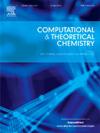Theoretical study of catalytic performance of X-γ-Graphyne as cathodes for lithium-air batteries
IF 3
3区 化学
Q3 CHEMISTRY, PHYSICAL
引用次数: 0
Abstract
Lithium-air batteries (Li![]() O2) are considered one of the most promising energy storage and conversion device candidates for future mobility applications, such as electric vehicles, due to their ultrahigh theoretical energy density (up to ∼3600 Wh kg‐1). The main goal in this work is to study an electrochemical catalytic model for a cathode in Li
O2) are considered one of the most promising energy storage and conversion device candidates for future mobility applications, such as electric vehicles, due to their ultrahigh theoretical energy density (up to ∼3600 Wh kg‐1). The main goal in this work is to study an electrochemical catalytic model for a cathode in Li![]() O2 batteries to simulate the OER during the discharging process. Density Functional Theory (DFT) calculations were performed to investigate γ-Graphyne and N-γ-Graphyne (N-Doped γ-Graphyne) as the potential cathode catalyst for Li
O2 batteries to simulate the OER during the discharging process. Density Functional Theory (DFT) calculations were performed to investigate γ-Graphyne and N-γ-Graphyne (N-Doped γ-Graphyne) as the potential cathode catalyst for Li![]() O2 batteries. γ-Graphyne and N-γ-Graphyne surfaces exhibit high stability according to calculations, the pristine surface exhibits a slight improvement in the formation energy of LixO2, moreover, the N-Doped surface can reduce the significant formation energy of LixO2 in the OER. Calculations explain the catalytic mechanism and identify the active sites to perform N-doping on pristine γ-Graphyne. This study demonstrates a feasible approach to achieve designed γ-Graphyne and N-γ-Graphyne as cathode catalysts for Li air batteries, which is promising for cost reduction in mass production of Li-air batteries.
O2 batteries. γ-Graphyne and N-γ-Graphyne surfaces exhibit high stability according to calculations, the pristine surface exhibits a slight improvement in the formation energy of LixO2, moreover, the N-Doped surface can reduce the significant formation energy of LixO2 in the OER. Calculations explain the catalytic mechanism and identify the active sites to perform N-doping on pristine γ-Graphyne. This study demonstrates a feasible approach to achieve designed γ-Graphyne and N-γ-Graphyne as cathode catalysts for Li air batteries, which is promising for cost reduction in mass production of Li-air batteries.

X-γ-石墨炔作为锂-空气电池阴极催化性能的理论研究
锂空气电池(LiO2)由于其超高的理论能量密度(高达~ 3600 Wh kg‐1),被认为是未来移动应用(如电动汽车)最有前途的能量存储和转换设备候选者之一。本文的主要目的是研究锂离子电池阴极的电化学催化模型,以模拟放电过程中的OER。利用密度泛函理论(DFT)研究了γ-石墨烯和N-γ-石墨烯(N掺杂γ-石墨烯)作为LiO2电池阴极催化剂的可能性。计算表明,γ-石墨烯和N-γ-石墨烯表面具有较高的稳定性,原始表面对LixO2的形成能有轻微的提高,而N掺杂表面可以显著降低OER中LixO2的形成能。计算解释了催化机理,并确定了在原始γ-石墨炔上进行n掺杂的活性位点。本研究为实现设计的γ-石墨烯和N-γ-石墨烯作为锂空气电池阴极催化剂提供了一种可行的方法,有望在锂空气电池的量产中降低成本。
本文章由计算机程序翻译,如有差异,请以英文原文为准。
求助全文
约1分钟内获得全文
求助全文
来源期刊

Computational and Theoretical Chemistry
CHEMISTRY, PHYSICAL-
CiteScore
4.20
自引率
10.70%
发文量
331
审稿时长
31 days
期刊介绍:
Computational and Theoretical Chemistry publishes high quality, original reports of significance in computational and theoretical chemistry including those that deal with problems of structure, properties, energetics, weak interactions, reaction mechanisms, catalysis, and reaction rates involving atoms, molecules, clusters, surfaces, and bulk matter.
 求助内容:
求助内容: 应助结果提醒方式:
应助结果提醒方式:


